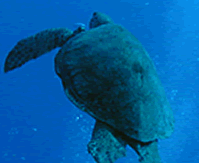
 |
||||||||||||
 |
||||||||||||
Going Under is a Good Thing:
Try Scuba
Brightly colored fish and eight-foot long sharks can be found in all the big aquariums that have become major attractions is cities and theme parks. You can wander slowly past thick glass walls watching strange creatures brought from almost every ocean of the world. Pay attention to the schedule, and you can see volunteer scuba divers descend into the huge tanks to distribute food. You can wonder what it might be like to do that, or you can join more than 180,000 people per year in America who take the literal plunge beneath the waves.
From age ten to well into their seventies and sometimes eighties, men, women, and children are making recreational scuba diving a growth industry. Training options have expanded and travel opportunities abound – the Florida Keys and the coast of North Carolina offer dives that draw visitors from throughout the U.S. and from around the globe. Whether single, a couple, or a family, scuba diving opens a world of adventure that surpasses a day at the aquarium. The extraordinary sensation of virtually flying underwater is matched by the wonder of spending time within the aquatic realm, observing marine life in its natural habitat. Although people dive in lakes and quarries, warm water destinations tend to be more enjoyable. Most dive shops arrange periodic trips for groups and happily give advice for individual or family travel.
Since the well-known shipwrecks of North Carolina aren’t predominantly for beginner divers, let me tell you instead about Key Largo, Florida; a ninety-minute drive from the Miami Airport. Key Largo, the first of the Keys on the 130-mile stretch to Key West, proudly claims to be the Dive Capital of the World. There is a wide range of operations with at least two dozen dive shops; some that provide diving and lodging combination packages, and all that provide/arrange boat charters to famous reefs and wrecks. Years of protection in the marine sanctuaries mean healthy coral systems and plentiful sea creatures. You’ll see dense schools of yellowtail snappers, colorful Parrotfish, odd-looking trumpet fish, moray eels, and groupers of all sizes to name but a few species.
Intrigued by the thought, but not sure how to proceed? Fundamentally, all Self-Contained Underwater Breathing Apparatus (SCUBA) training consists of swimming pool sessions, class work, examinations, and open water sessions. From this basis, however, there are multiple options. One day or half-day introductory courses that are popular in vacation spots, or aboard cruise ships, can have you underwater with an instructor with minimal training. These excursions give you a taste of the extraordinary undersea world and can be a building block for further training. Even though full certification can be completed in only three days, that can be physically stressful. A focused course can be accomplished in four to seven days or sessions can be held over a series of weeks. Classes are group, semi-private, or private, and it is becoming commonplace for families to learn together. A particularly attractive approach for people who don’t live near a dive destination is to use referral training. This allows you to finish all the classroom and swimming pool work in your home location, take the required examination, and complete the final two or three days somewhere like Key Largo. Thanks to the expanding recreational scuba diving industry, dive shops and training centers can be found from Arkansas to Wyoming as well as in coastal states. A quick internet or telephone book search can locate the training center closest to you.
What can you expect in training? Not surprisingly, you learn very basic physics of diving and how to handle scuba equipment. Safety is the foremost issue. You are taught skills that minimize the possibility of having problems underwater, and how to quickly resolve, any that do arise. Having your mask dislodged doesn’t happen often, yet you repeatedly practice this scenario in order to understand the procedure for coping with it if it does occur. The objective of the course is to ensure your comfort level when you take that exhilarating step from the surface.
Prices for training vary according to region, although a rule of thumb is $400-500 per person. Be sure to ask if the price quoted includes training materials. It is customary to purchase your own mask, snorkel and fins, but the actual S.C.U.B.A. equipment is usually included in the price of the course. Once you are certified, you can rent whatever you need. Most professionals don’t recommend purchasing a full set of gear until you know how often you might be diving. On-going costs for recreational scuba diving are similar to golf or downhill skiing.
Do you have to be a strong swimmer? Not really. Unlike the early days of bulky equipment, scuba today is far more about technique than strength. If you engage in any sort of regular exercise, you should be able to dive. The past decade has led to an array of technical gadgets and enhanced equipment design; especially for women and children.
There are a few medical restrictions such as chronic ear pain, but most conditions are compatible with diving. Dive shops have fairly standard release forms you can review and then consult your physician if you have any of the medical conditions listed on the form.
Fine so far, but what about toothy, stinging critters that lurk below? My husband’s favorite statistic is that more people are killed each year by pigs than by shark attacks. Despite what you see in movies and news headlines, shark attacks against divers are extremely rare. I will admit a degree of reluctance the time I was talked into going on a shark-feeding dive. The flat-eyed beasts were only interested in the morsels offered by the trained feeder, and we even have a video tape of the event. Toothy barracudas abound in the Florida Keys, and those were the fish that it took me a few dives to become accustomed to. The truth is that humans are not in the food chain of marine animals, and a little common sense keeps you from harm.
“Okay, I admit that I’m hooked,” acknowledged a friend who initially declined her brother’s suggestion to take up diving when her husband did. She felt it would be more trouble than it was worth, and sent the men off to have a good time. Enthused with his own experiences, her husband finally persuaded her to brave chilled waters of Maine to get through the classes. He promised a follow-on excursion to the Caribbean as an incentive. Her skepticism disappeared when she slipped into clear Bahamian waters and saw gently swaying purple sea fans, darting tropical fish, and languidly swimming sea turtles. Within a few months she excitedly urged two of their three adult children to become certified. Most of their leisure travel is now centered on where they go for dive vacations.
There’s no need to be concerned, however, if you become enamored of diving and people that you travel with do not. From luxurious accommodations to rustic camping, the Florida Keys and other areas that specialize as dive destinations, have plenty of non-submersible activities available. You can indulge your newfound underwater freedom while others in your party select from tours, different water sports, hiking, shopping, or any number of pursuits.
As a final note, if you’re a die-hard, multi-tasking person, and feel that the pure pleasure of diving is not enough reward, there are dozens of ecological projects that embrace volunteer divers. You can help restore damaged reefs, participate in fish counts, or perhaps replant fields of sea grasses that provide shelter for marine-dwelling juveniles.
Scuba diving is not an activity for everyone, yet is far easier to try than you might think. Log onto www.padi.com and www.naui.org for more information or stop by a local dive shop and talk to the staff. Happy Diving! CH
Copyright © 2001-2025, Charlie Hudson. All rights reserved.